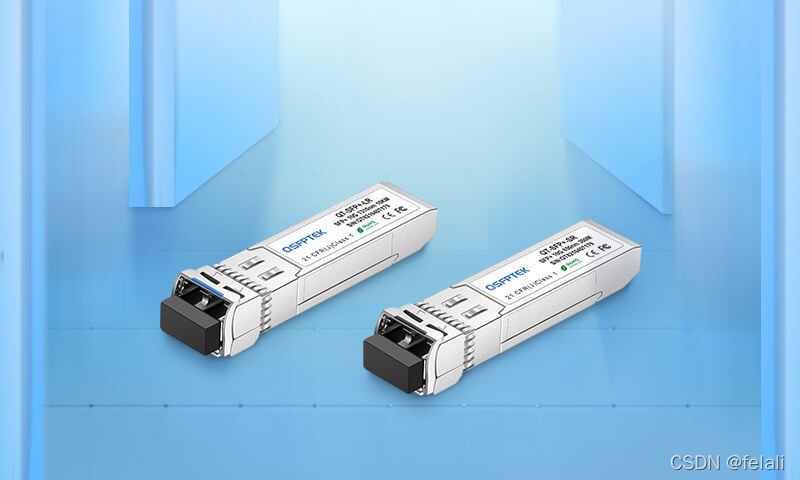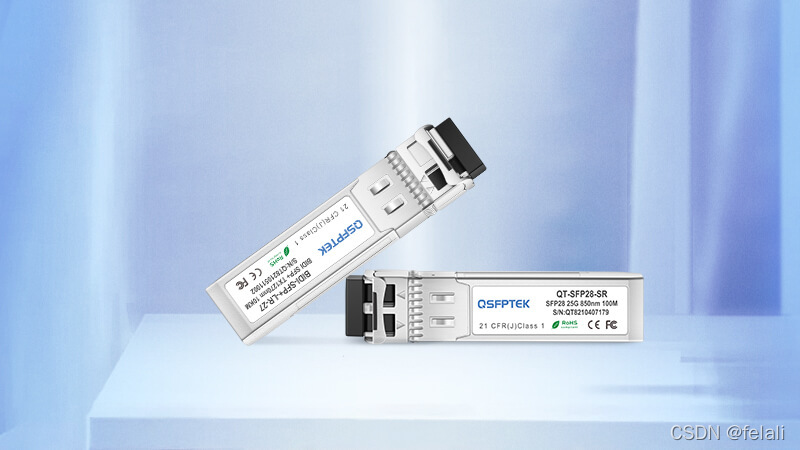SFP modules are common terminologies for those who deal with fiber optics technologies. The SFP models have revolutionized data transfer by acting as critical components necessary for seamless data transmission. It is essential to distinguish between the SFP+ vs SFP transceiver models. A better understanding enables one to choose the best hardware and use it for optimal performance. The article explains the differences between the SFP vs SFP+ modules. Further, it gives recommendations on when best to use either of the SFP optical module technologies.

Figure 1: SFP vs SFP+ manufactured by QSFPTEK
Overview of SFP vs SFP+ Optical Module Transceivers
An SFP, small-factor pluggable, is defined as a compact and hot-swappable transceiver primarily used to link a switch or other devices connected to a network device to fiber or copper cables. Initially, the gigabit interface converter (GBIC) was the go-to solution. Despite SFP replacing the GBIC, it is also commonly known as Mini-GBIC. Ethernet and fiber cables are connected with SFP modules or SFP cables on a switch to attain varying speeds.
The IEEE802 and SFP-8472 are the governing specifications for the small factor pluggable, SFP. A greater number of enterprise-class switches have two or more SFP ports. The switches and ports allow them to be a star-based or a ring network topology distributed in various buildings, different floor levels, and connected through optic cabling.
In 2006, the SFP+ standard was released and later updated in 2011. Rates of up to 16Gbps can be supported by the SFP + modules. Similar to the initial SFP model, they accommodate cabling using both copper and fiber. However, connections made through copper have distance limitations, only reaching a maximum of 10 meters at speeds of 10Gbps. Also, SFP plus allows for single-mode fiber connection running distances of up to 40 km. However, other vendors offer distances that exceed 40 km to a maximum of 80 km. WAN connections are also supported by SFP+ using Optical Transport Network specification OTU2.
The Critical Distinction Between SFP vs SFP+ Transceiver Modules
The main difference between SFP and SFP plus is linked to their transmission speed. The earlier version, which is SFP, supports speeds of up to 10/1000 Mbps of Ethernet speed. Alternatively, SFP+ that is the latest version accommodates speeds of up to 10Gbps.
The second distinction between SFP vs SFP+ is based on varying data rates, transmission distances, and applications. As mentioned earlier, SFP possesses a more extended transmission range. Also, SFP-8431 governs how SFP+ operates.
Another critical difference is the SFP vs SFP+ compatibility issue. For instance, SFP + modules are compatible with SFP ports, but there is a speed limit where the maximum speed will lower to 1Gbps. Important to observe is that an SFP+ transceiver is not pluggable into an SFP port because SFP+ does not support rates below 1Gbps. Due to the great distances and speeds linked with the SFP+. SFP+ module is the typical 10 Gigabit Ethernet module available.
Table Below shows the summary of differences between SFP and SFP+.
 A key observation to note is that both SFP vs SFP+ have the exact sizes and appearance. However, SFP+ is more expensive compared to the SFP module. A significant distinction between the transceiver modules is that SFP+ is applied in Ethernet applications while SFP is best suited for 100base or 1000Base applications. Further, 10G data rate transmissions cannot be accommodated by SFP, which means they are not used in the same network. SFP+ transceivers use the same parameters as pluggable transceivers operating in 10 Gbit/s Ethernet and 8.5Gbit/s fiber channels with SFP. SFP+ is compliant with SFF-8431 standards, while SFP complies with SFF-8472 AND IEEE802.3 standards.
A key observation to note is that both SFP vs SFP+ have the exact sizes and appearance. However, SFP+ is more expensive compared to the SFP module. A significant distinction between the transceiver modules is that SFP+ is applied in Ethernet applications while SFP is best suited for 100base or 1000Base applications. Further, 10G data rate transmissions cannot be accommodated by SFP, which means they are not used in the same network. SFP+ transceivers use the same parameters as pluggable transceivers operating in 10 Gbit/s Ethernet and 8.5Gbit/s fiber channels with SFP. SFP+ is compliant with SFF-8431 standards, while SFP complies with SFF-8472 AND IEEE802.3 standards.
Types of SFP and Updates
Besides SFP vs SFP+, What are other form factors of the SFP module? Industries have continuously scaled SFP specifications to provide higher rates and increase interconnection types. About 25 Gbps is supported by SFP28 using both multi-mode and single-mode fiber. Also, bidirectional communication support is available by BiDi SFPs over a single fiber. Other types of SFP use two fibers whereby one is for sending and the other for receiving. Also, different wavelengths are used with BIDI SFP for data transmission and receiving data.
Two bidirectional links can be supported through a similar module interface when using compact SFPs. Two fibers are necessary to support bidirectional traffic. Quad SFP (QSFP) modules allow for four fibers transmitting Ethernet Infiniband or FC. Most accessible modules can accommodate up to 200Gbps. When working with extended data rates such as 400Gbps, both octal QSFP, and SFP can be used.

Figure 2: SFP28 vs BiDi SFP+ manufactured by QSFPTEK
Summary
At the moment, 400Gbps is the highest data rate that is used in commercially available products. There is work in progress to come up with products and standards that accommodate 800Gbos. SFP technology has shown the ability to change with increasing demand, and it will further develop to accommodate higher data rates. Small form-factor pluggable specifications are specified in the SFP Multi-Source agreement that allows for the mixing and matching of components from different vendors specific to SFPs. When using SFP modules, it is essential to ensure compatibility by reviewing a vendor's optics testing report. Further, one can request a vendor to provide compatibility information.
The SFP transceiver type chosen depends on aspects such as the type of cable and application. The desired optical range and the needed data transmission rate is also a factor to consider. To get SFP and SFP + transceiver modules best deals, we recommend QSFPTEK. The company is a global fiber optic manufacturer and seller providing both SFP vs SFP+ transceiver modules. Further, you can get expert consultation via sales@qsfptek.com before settling on the best module of choice. Check out the SFP price list and make an order today.
Related Article:
SFP vs SFP+ vs SFP28 vs QSFP+ vs QSFP28 Compatibility
SFP Module Prices Comparison by Top 5 SFP Manufacturers 2021

























 被折叠的 条评论
为什么被折叠?
被折叠的 条评论
为什么被折叠?








